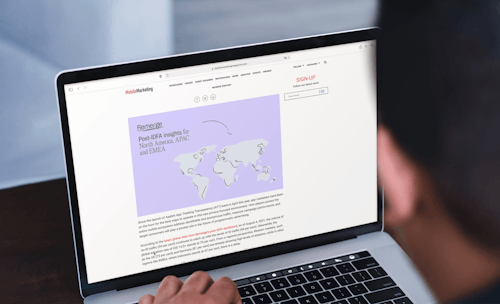How are app marketers running programmatic campaigns after ATT?
September 01, 2021

This content was originally published in Mobile Marketing Magazine.
Since the launch of Apple’s App Tracking Transparency (ATT) back in April this year, app marketers have been on the hunt for the best ways to operate in this new privacy-focused environment. How players across the entire mobile ecosystem address identifiable and anonymous traffic, measure campaign performance, and target consumers will play a pivotal role in the future of programmatic advertising.
According to the latest global data from Remerge’s post-IDFA dashboard, as of August 4, 2021, the volume of no-ID traffic (34%) continues to catch up with the levels of ID traffic (66%). Meanwhile, the global adoption rate of iOS 14.5+ stands at 70%. From a regional perspective, Western markets, such as the US (73%) and Germany (81%) are already showing high levels of adoption, while in other regions like INSEA, where Indonesia stands at 57%, there is a delay.
App marketers are reacting differently to these developments around the world and in a new report, Remerge experts recently shared their thoughts and analysis on programmatic trends across North America, APAC and EMEA.
Advertisers doubling down on ID traffic
Patrick Eichmann, General Manager, Americas
App marketers are in a tough spot at the moment, particularly as not all players in the space are fully equipped for SKAdNetwork. MMPs, SSPs, and DSPs are at different levels in terms of readiness, however, I am encouraged by the progress that’s been made since May, where SKAdNetwork-enabled bid requests surpassed the 50% mark in the US.
While technology vendors are prepping for this new era, it’s clear marketers remain unsure about certain elements of their campaigns: how am I going to measure the performance of my iOS spend? How will I handle conversion values? How do I know if it’s the right time to put more effort into media mix modeling and incrementality? It will take time to properly address these deeper business questions, but that’s not to say marketers should stand still.
Right now, there are real opportunities for mobile advertisers in the region. IDFA will eventually die out, so I would take advantage of its presence while it’s there. In June 2021, we saw that an average of 63% of bid requests in the US were still with an ID, meaning that for our customers, there has not been a significant impact on the performance of their campaigns. Because performance remains relatively strong, some of our biggest clients in the US are doubling down here. Many of them are using this period to analyze the granular data and insights from these ID campaigns, knowing that it will benefit their business in the long run and help them navigate the emerging privacy-centric world.
Continued spend on Android and ID iOS users
Hide Cho, Country Manager, Japan and Korea
In South Korea, marketers are behaving based on the type of app they have and where it is available. For instance, gaming and content companies that are active in Western markets, such as the US and Europe, are paying close attention to developments around iOS 14 and what advertising options are at their disposal. Meanwhile, domestic businesses, which include apps for non-gaming verticals such as commerce, food-delivery and subscriptions, are more concerned about Android users, as this market dominates South Korea (although the share of iOS is increasing).
Much like the US, Japan is an iOS heavy market overall, so the ATT changes have caught the eye of almost all app marketers, with many looking for both short and long-term solutions and best practices from overseas. At the same time, companies are starting to test new methodologies such as incrementality and experiment with ID-less traffic.
For South Korea and Japan, the focus will shift towards user acquisition and owned media as adoption rates for the latest iOS versions grow. I believe we’ll also see more organizations embrace SKAdNetwork. For now though, advertisers will continue to spend on Android and available ID iOS traffic.
« Android dominates the INSEA market and this gives companies operating in the region a distinct advantage. »
Maria Abdull Latif, Regional Manager, INSEA
Retargeting remains a priority
Maria Abdull Latif, Regional Manager, INSEA
At the moment, advertisers are still concentrating on their Android user bases. Retargeting and re-engagement campaigns have not lost any momentum in the region, particularly for verticals such as gaming and e-commerce, where big players continue to invest heavily in this approach to grow their app audiences.
Android dominates the INSEA market and this gives companies operating in the region a distinct advantage. As the iOS world evolves, they can use this period to test SKAdNetwork, enhance their performance attribution and improve budget decisions, while at the same time learn from what others are doing in more iOS driven environments. Investing in no-ID at this point will have a minimal effect on the status quo, however, in the mid-term, it will put advertisers in a strong position when it comes to navigating the eventualities of an anonymous future, for both iOS and Android.
Advertisers must search for alternatives
Kate Taganova, Director of Sales, EMEA
In EMEA, advertisers are reacting differently to the rollout of Apple’s new features and can be divided into two groups. The unpredictable nature of the market means we’ve seenone set of app developers play the waiting game and hold back on making any concrete decisions, largely because running high-performing retargeting campaigns is still doable on iOS. Similar to what we’ve seen in the US, the other group is using this time to gather learnings and plan for the new ID-less reality, as the entire industry will eventually have to align with Apple’s vision for user privacy.
Recently, adoption rates for newer versions of iOS have accelerated in the region, meaning there is less ID inventory. Germany, Bosnia and Herzegovina, and Montenegro are among the top countries with the highest volumes of no-ID traffic (July 2021). Previously successful mobile strategies based on identifiable audiences are expected to fade away and advertisers must start looking into alternatives if they want to remain profitable in the future.
While the share of iOS in EMEA varies from country to country, the situation is affecting everyone in the region. We anticipate that there will be a significant reduction in advertising budgets on iOS until there is a strong product in the market that fully meets these new needs.
Apple’s update and the current limitations of measuring campaign performance with SKAdNetwork have forced data-minded marketers to experiment with incrementality. At Remerge, we’ve seen that early adopters of this methodology, such as Delivery Hero and PhotoSi, are reaping the benefits. In time, as the amount of anonymous users starts to outweigh those that are identifiable, the industry will get an even better understanding of how to measure performance on no-ID traffic and we will start to see a recovery in iOS spend.
A closer look at Remerge’s dashboard data
Access ID or no ID? A regional take on the latest trends and data for the full report and analysis from Remerge’s experts.





